Guide To Trampoline Safety
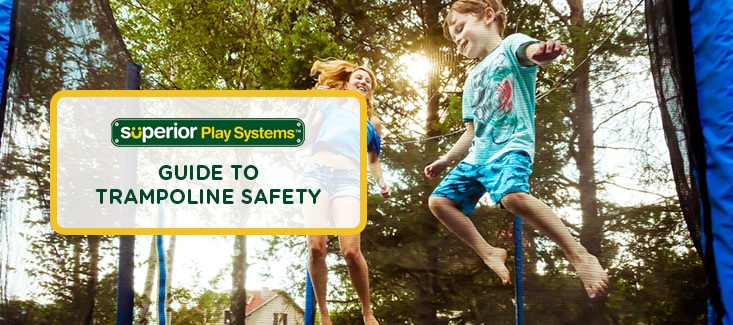
Kids love to jump on trampolines, and the activity can improve their health by keeping them active. If you’re like most parents, you feel serious concern about injuries your kids could get from jumping outside. Are trampolines really dangerous? The answer is not as clear-cut as you would think.
Establishing safety guidelines for your kids and finding the right trampoline safety features can help you reduce the chances of injuries while giving your kids a fun place to play outside.
Are Trampoline Safe or Dangerous?
Like many pieces of outdoor play equipment, trampolines can pose a hazard to unsupervised kids, but you can control several factors to make these devices safer. By choosing the right trampolines and encouraging safe play, you can keep your kids safer.
Trampolines can be a part of your children’s healthy lifestyle by increasing their aerobic activity. The World Health Organization (WHO) suggests that children between ages five and 17 should get at least an hour of moderate to intense aerobic exercise daily. The organization also encourages kids to engage in weight-bearing activities such as running and jumping, which help build bone density.
When it comes to whether trampolines are safe or dangerous, it depends on how you look at the data. Compared to commercial jump parks, the injury rate for home trampolines was higher, but the problems did not result in fractures or surgery as often. For example, only 17% of home trampoline injuries resulted in dislocations or fractions, and only 10% of injuries needed surgery. For commercial jump parks, the rates of fractures were 45%, with 23% of injuries requiring surgery.
While you’re never guaranteed complete safety with any activity, home trampolines with adequate supervision and safety features may be a better option for you and your kids than a commercial jump park.
Comparing trampolines to other forms of play children can do, the types of injuries do not differ significantly. A pediatric orthopedic surgeon at the Mayo Clinic, Dr. William J. Shaughnessy M.D. likens the injuries from trampolines to those of playgrounds and bicycles. You cannot completely get rid of any chances of injuries for kids on trampolines, but you can mitigate the danger.
Trampoline Injury Statistics
Injuries on trampolines stem from improper jumping or not having enough supervision. The most common injuries from home trampolines involved the lower extremities, with 40% of incidents involving the legs or feet. Hands and arms came in a close second for damages — with 29% of reported hurts.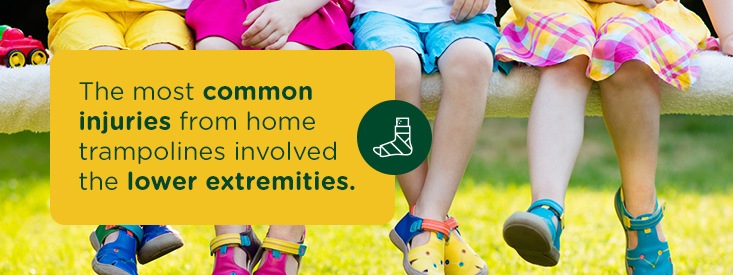
Injuries that most often resulted in emergency room trips happened from falls off the trampoline, impacting the springs, jumpers colliding with each other or jumpers trying dangerous flips. Luckily, the majority of those treated in emergency rooms for trampoline injuries did not need hospitalization. Only 4% of those who went to the emergency room required admission into the hospital for treatment.
Thankfully, most of the injuries on trampolines do not result in death. Over nine years from 1990 to 1999, only 11 deaths came from trampolines, with six of those happening to children between 12 and 19.
Despite the low number of deaths, injuries still occurred most frequently to children. Those ages six to 14 had the highest rate of hurts. Two-thirds of people who sustained injuries while on trampolines were within this age group.
Outdoor Trampoline Safety Tips
When allowing your kids or other adults to jump on a trampoline, keep these trampoline safety rules in mind to ensure everyone stays protected while they play. If needed, print out these rules to have posted near the trampoline so no one will forget. Teach these trampoline safety tips for kids jumping habits while reminding other adults in your home about them.
1. Only Play With Adult Supervision
Even adults using the trampoline should not play alone. Having someone on hand ensures there will be a person to get help if needed. Adults also serve as spotters for kids, making sure the children follow the established trampoline safety guide you’ve outlined.
In previous studies, adults were present only 55.6% of the time when a child got injured. This statistic highlights the need to have adults watching their kids while they jump. If more than half of the injuries occurred with supervision, that means almost half happened when kids were alone.
For children, adult supervision will ensure they do not try dangerous stunts while jumping. Do allow your kids to try somersaults, flips or other gymnastics moves on the trampoline. These could result in serious injury. Of parents who had a child injured on a trampoline, 56.9% reported that their child had tried one of these dangerous moves at some point before their injury. Preventing your kids from trying flips could protect them from future injuries.
2. Arrange a Safe Play Area
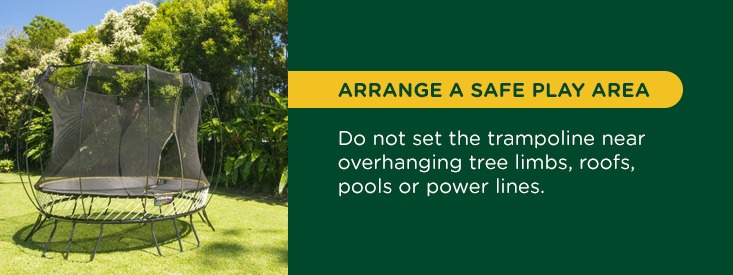
The placement of the trampoline will ensure your kids have a safe, secure jumping place. Do not set the trampoline near overhanging tree limbs, roofs, pools or power lines. Kids could hit these while jumping. Even worse, the temptation to leap from a rooftop or tree onto the trampoline is too high. Never allow kids to jump from other surfaces onto the trampoline or use the trampoline to jump into pools.
Have plenty of light in the area. You don’t want portions of the trampoline or nearby ground in shadow where an adult supervisor cannot see children. Ensure the feet of the trampoline rest securely on flat ground. Surround the area with soft landing material such as wood or rubber mulch.
Since many trampolines do not come with ladders, purchase one to give your kids a safe way to get from the trampoline to the ground. Remove the ladder when your kids leave the trampoline at the end of the day to prevent unauthorized use of the play area.
Like swimming pools, you may have municipal requirements to fence your trampoline in to prevent neighborhood kids from accessing it. Without a fence, you may find yourself liable if an accident does occur from someone jumping on the trampoline without your knowledge.
3. Follow Directions
Look at the directions for your trampoline model. Never allow jumpers to exceed the maximum weight restrictions for the trampoline’s design. You must add the weights of multiple people who are on the jumping surface at the same time to verify the total stays below the recommended level. Surpassing the maximum load can shorten the life of the trampoline while making jumping more dangerous.
Also, follow the manufacturer’s recommendations for inspecting the surface of the trampoline, springs and enclosure. Check these regularly before and after any jumping sessions.
4. Limit Jumpers and Kids Nearby
Don’t allow more than one person to jump at a time. Jumpers colliding with each other is one of the top causes of injuries requiring a trip to the emergency room. Having multiple jumpers, especially those of vastly different sizes, poses a severe hazard. The larger child can land on a smaller one, causing severe injuries.
In many instances, injuries happened not to kids jumping on the trampoline but those standing too close. Never let children stand, crawl or sit under a trampoline, whether someone is jumping on the surface or not.
Consider the ages of those jumping. Don’t allow kids under six to jump on a trampoline because 15% of injuries occurred in those younger than this age.
5. Choose Trampolines With Safety Features
Don’t neglect safety features when choosing the right trampoline for your backyard. Adding a net to a trampoline can cut a child’s chances of a broken bone in half. All our trampolines have netting around them to keep your kids safe. Even with a net, however, it’s important for your kids to bounce safely to avoid getting hurt. One child, for instance, broke both arms because he jumped over the safety net. Keeping a close eye on your kids is still critical to preventing such injuries.
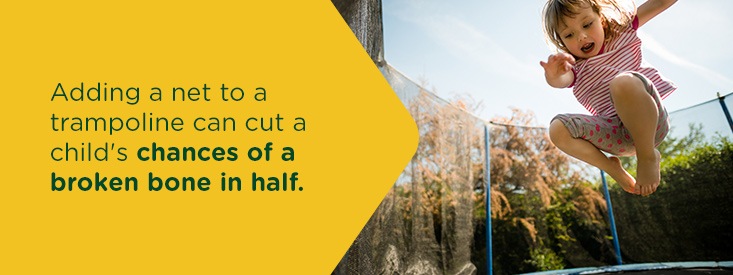
Other features you may need include a no-tip design. You don’t want the trampoline to turn over just because a child jumps near the edge. If your model does not have a no-tip feature, invest in an anchor kit that screws into the ground to keep the trampoline upright.
Installing a ladder on the trampoline helps you to limit access to the jumping surface when you cannot watch the kids. Ladders also make it safer for your kids to get onto high trampolines.
Most trampolines have padding covering the springs. If your model does not, you can ensure your kids are safer by investing in one. Falling between springs can cause severe foot and leg injuries. Uncovered springs can also pinch tiny fingers and toes. Having a cover and pad will cushion your kids if they fall onto this portion of the trampoline.
6. Remove Dangers
If your children wear jewelry, have them remove all pieces before getting on the trampoline. Earrings or necklaces can poke at delicate skin. Even rings can strike other kids, causing bruises. The same applies to any hard hair accessories like headbands or barrettes.
Tell kids to empty their pockets before getting on the trampoline, too. Keys, coins, toys and other items in their pockets can injure them while jumping.
Don’t let kids jump while wearing shoes. Have a designated space next to the trampoline ladder for your kids to place their shoes while they bounce. By putting all the shoes into the same place, you can quickly determine if everyone jumping has removed their shoes as requested. Taking off shoes will also help to increase the life of the jumping surface of the trampoline.
Why AlleyOOP® Trampolines?
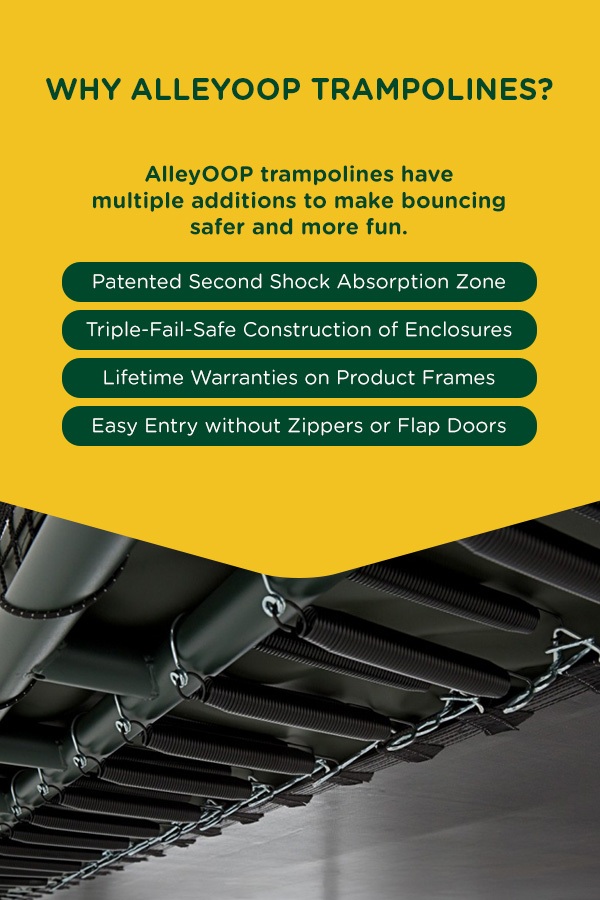
When looking for the right trampoline, you want to compare the safety features of several models. AlleyOOP® trampolines have multiple additions to make bouncing safer and more fun.
The springs have construction of durable piano wire. They stretch deeply, which reduces the impact you feel on your feet and legs when jumping. To lower the rebound effect of the trampoline on the jumper, AlleyOOP® uses adjacent springs with alternating high and low tensions from long and short D-rings.
AlleyOOP® Double Bounce trampolines have a 50% softer landing thanks to their patented second shock absorption zone. If you have multiple people jumping, the Double Bounce system reduces injuries.
AlleyOOP®’s construction is so sturdy and long-lasting that the company offers lifetime warranties on its products’ frames. The enclosures around these trampolines go beyond the standard design and have a Triple-Fail-Safe construction. Frames supporting the trampolines feature heavy-duty construction. Whether you choose a Double Bounce trampoline or one of AlleyOOP®’s Variable Bounce models, you get the same lifetime warranty on the frames.
Because you should monitor how many kids are bouncing at once, not everyone will be able to be in the bounce zone. If you have AlleyOOP® trampolines, your kids can stand in one of the rest zones along the edges without affecting the jumper or getting bounced out of the play area.
With trampolines from this brand, you don’t have to keep reminding your kids to close the door for the net. Unlike other net enclosers with zipper or flap doors, trampolines from AlleyOOP® have an entry that allows kids to slip inside but not fall out.
Why Springfree® Trampolines?
Springfree® trampolines increase the jumping surface by removing the springs. Your kids still get the bounciness they love, but not the chances of falling through holes between springs or falling off the surface. Without springs and with an enclosed bouncing area, your kids can be safer while they jump.
Though you can get Springfree® trampolines as large as 11-by-11 feet, their designs prevent tipping — no matter where your child jumps on the surface. Because the construction does not have an outer ring of springs, your kids get the same amount of jumping area of this trampoline as they would on a 14-foot traditional model.
Both AlleyOOP® and Springfree® brands offer multiple safety features, so the only thing to choose is the one your kids would prefer to jump on. If you don’t know which trampoline model your kids will prefer, have them try out both brands before you purchase the right one for your family.
Visit Our Showrooms to Try Our Trampolines
You wouldn’t buy a car without test driving it, so why would you invest in a trampoline without letting your kids test-bounce it? The best way to find the right trampoline for your family is by trying them out in person. Bring your kids to one of our showrooms to see first-hand what our products look like and which trampoline safety factors they have. Do your kids prefer the traditional springs found on AlleyOOP® trampolines, or do they like the Springfree® designs with larger jumping surfaces?
We feel as strongly about safety as you do. That’s why we only offer trampolines that have particular features that make them safer options for your home. We’ve been in the outdoor play business for 20 years, and we know precisely the features to reduce injury risk. Our safety knowledge ensures we sell trampolines you can safely enjoy with your whole family for years to come.
Contact us with questions about our trampolines, locations, birthday parties or any other concerns you have. We’d love to hear from you.

